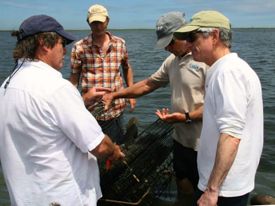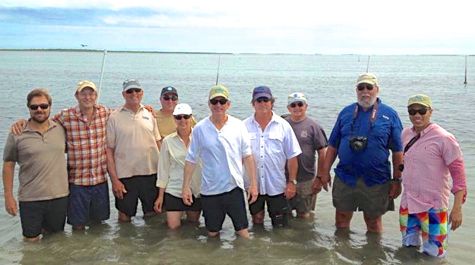Congressman Rigell visits Eastern Shore restoration sites
Virginia’s second congressional district, home of Representative Scott Rigell, preserves some of the last undeveloped coastal areas between Florida and Maine, including 4,700 acres of eelgrass meadow restored by the Virginia Institute of Marine Science and a consortium of state, federal, and private partners.
Rigell and his Senior Congressional aide Esmel Meeks recently got a first-hand look at the results of these restoration efforts during a daylong trip to South Bay, the epicenter of a 16-year collaboration to restore eelgrass, oysters, and now bay scallops to the seaside bays of Virginia’s Eastern Shore. All three species have played an important role in the area’s environment, economy, and culture.

Partnering in the on-going collaboration are VIMS, The Nature Conservancy, the University of Virginia, and the Virginia Marine Resources Commission, with funding from Virginia’s Coastal Zone Management program, NOAA’s Restoration Center, and several other state, federal, and private supporters.
VIMS professor Robert “JJ” Orth, the architect behind what has become the world’s most successful eelgrass restoration project, says “Scott and Esmel were very engaged, asking lots of questions about the work we are doing. They saw the results of that work directly, wading for almost an hour through a restored eelgrass bed to the site of our incipient restoration effort for bay scallops.”
“I had a wonderful time on South Bay with the good men and women who are working hard every day to preserve our treasured waters and marine life," says Rigell. "It felt great to have the sun on our faces and our feet in the water. We are fortunate to live in what I believe is the most beautiful area in the country, and with that comes solemn responsibility to preserve and protect it. Working together, we can, and we will leave clean air, clean water, and clean soil to our children and grandchildren. That’s not a Republican goal or a Democratic goal; it’s an American goal."
Heading the bay-scallop restoration effort in South Bay is Professor Mark Luckenbach, Associate Dean for Research and Advisory Services at VIMS. During the visit, he showed Rigell and Meeks the cages that hold the juvenile scallops his team has deployed at the site, and discussed the past, present, and future status of these delectable bivalves. Bay scallops, which depend on eelgrass for their primary habitat, supported a thriving commercial fishery in the area until the 1930s, when an eelgrass wasting disease and a large hurricane wiped them out.
During their visit, Rigell and Meeks also visited the area’s oyster-restoration sites, where Barry Truitt of The Nature Conservancy and Jack Travelstead of the Virginia Marine Resources Commission joined with Luckenbach to discuss methods and strategies for oyster restoration. Luckenbach stressed good water quality and the native oyster’s increased tolerance to disease as two important ingredients in the team’s restoration success.
VIMS Dean and Director John Wells says “We’re grateful and impressed that Congressman Rigell carved out time from his many other duties to learn how state and federal investments in the marine resources of Virginia’s Eastern Shore are leading to successful outcomes for the area’s environment, businesses, and communities.”
“I think Scott and Esmel really enjoyed the visit,“ adds Orth. “While the Congressman’s visit was only supposed to last 90 minutes, he gave us a couple of extra hours in the field. The day couldn’t have been more perfect weather wise. The tide was low, and the water clarity was superb.”
Also taking part in Rigell’s visit were Laura McKay of NOAA’s Coastal Zone Management program, Bo Lusk and Dave Phemister of The Nature Conservancy, Art Schwarzchild of the UVA’s Long-term Ecological Research site in Oyster, Virginia, and Walt Priest of the NOAA Restoration Center.
The South Bay restoration efforts take place on both state- and Nature Conservancy-owned bottom within the Virginia Coast Reserve, a 38,000-acre coastal wilderness that runs more than 60 miles from the Maryland border to the mouth of Chesapeake Bay.
Overall funding for the restoration effort comes from numerous agencies, notably the Virginia Coastal Zone Management Program at the Virginia Department of Environmental Quality (a network of state agencies and coastal localities operating with funding from administered by NOAA’s Office of Ocean and Coastal Resource Management), the Virginia Recreational Fishing License Fund, the American Recovery and Reinvestment Act, The Nature Conservancy, the U.S. Army Corps of Engineers, the Virginia Department of Transportation, and private grants from the Allied-Signal Foundation, Norfolk-Southern, and the Keith Campbell Foundation for the Environment.


